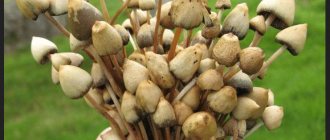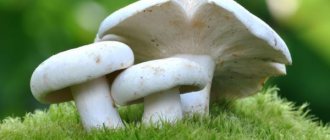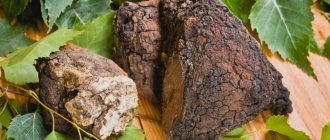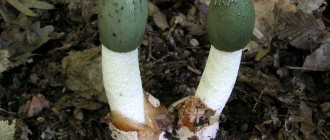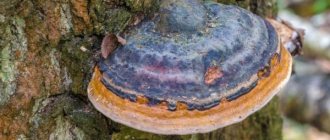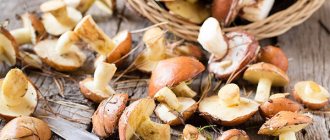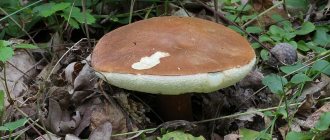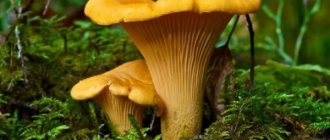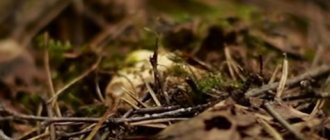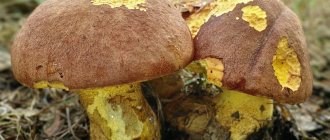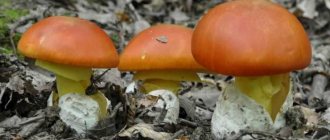Even experienced mushroom pickers try to avoid deer spittle, considering it an inedible or even poisonous mushroom. Some forest dwellers, especially deer and elk, happily consume these inconspicuous representatives of the mushroom family, which serves as sure proof of their edibility. If even this is not enough to allow the venison to take its rightful place on the table, you should not pass by these mushrooms because they are valued in folk medicine and have numerous medicinal properties.
Pluteus umber
This is a conditionally edible mushroom. Its cap can reach up to 10 cm in diameter. It is whitish in color, has wrinkles, and in the center there is a small tubercle. Young forms are distinguished by a more semicircular cap. Over time, it takes on a prostrate shape. The pulp has a whitish tint and changes at the point of cut. It tastes quite bitter and smells like fresh radish.
This type of mushroom often grows in the forests and parks of our country. It is often confused with Plutaeus staghorn. They are very similar, but differ in a number of ways:
| Pluteus umber | Pluteus deer |
| The plates are delicate, very loose; young mushrooms have a whitish color | Has a more intense dark color of coarse plates |
| The leg is up to 10 cm high and has a gray-whitish or brown color. There are small scales along the entire length. It has a cylindrical shape that tapers downward. Solid and fairly dense structure | The cylindrical legs of the mushroom reach up to 15 cm in height. Dark brown in color, covered with scales along the entire length. |
| Can be found on the woody remains of oak trees, as well as on rotten stumps of ash and poplar trees. | Lives in coniferous and deciduous forests |
This mushroom grows mainly in the summer and until mid-autumn. On the territory of Russia, its species can be found most often in the Samara, Rostov and Perm regions.
It is used in food quite rarely. For safe consumption, the plums must be soaked and boiled several times.
The mushroom acts only as a component of various dishes, because in itself it is absolutely tasteless. It is not found in traditional medicine recipes. Other names:
- shadowy spittle;
- Pluteum umbellata;
- Plute bordered-plate.
Use of mushroom in medicine
Although the mushrooms are not used in official medicine, mushrooms can be used in home treatment - there are many recipes that are recommended even for serious illnesses. The only warning is that you should not replace traditional treatment prescribed by specialists with folk remedies. It is better to use mushroom “medicines” as adjuvant therapy.
Tincture to strengthen the immune system and prevent cancer:
- Sort out the fresh mushrooms, discard the spoiled ones, and rinse under running water (it’s convenient to do this using a colander).
- Cut the plumes into large pieces and place them in a clean glass container.
- Pour in alcohol or double-distilled homemade pervach (the alcohol component should cover the mushroom particles by 1-2 cm).
- Seal the container and place in a cool, dark room.
- Over the course of a month, shake the bottle regularly to mix the contents.
- Strain, pour into a clean container, and store in the refrigerator or cellar.
Take the prepared tincture three times a day. The recommended dosage is 20 ml at a time. If alcohol components are poorly tolerated, it is allowed to dilute with cold water.
A decoction for treating ulcers, burns or non-healing wounds:
- Prepare a wound-healing regenerating agent using dry mushrooms: after washing, spread the sparrows in one layer on parchment-lined baking sheets and dry in a dryer or oven.
- Break dry mushrooms (20 grams) with your hands and place in a cooking container.
- Bring water (300 ml) to a boil, pour in the mushroom mixture.
- Place the container on the stove and simmer for about half an hour at a minimum boil (it is better not to remove the lid while cooking).
- Leave to steep until cool.
For treatment, soak soft tissue in warm broth and place on the affected area of the skin. Leave for half an hour, after the procedure, rinse the skin with warm water. Repeat twice a day.
To disinfect and heal wounds, you can prepare an ointment, for which it is recommended to use plutea spores. Mix them with Vaseline (take in equal proportions), mix. After three days you can use it for treatment - rub it with light massaging movements into the affected areas of the skin.
mushrooms are used in cooking to prepare tasty and healthy dishes
Pluteus willow
It is an edible species, but in the 1980s researchers recognized it as hallucinogenic. Its cap is about 7 cm in diameter, the color is grayish-ashy, sometimes even pink or blue. Young representatives have a bell-like cap, which over time changes to an open one. The edges of the cap are often darker than the center. Mushrooms of this species have a white stem, which tapers upward, and has the shape of a cylinder. Its structure is somewhat fibrous.
The flesh of the mushroom is light, sometimes even whitish. In its raw form, the mushroom has a sour taste and a rather intense anise aroma.
Found on roots, stumps and remains of rotten wood. It often grows on willows, oaks, and poplars.
It is consumed exclusively in dried form. In folk medicine it is not applicable in any way.
Morphological characteristics
Pluteus is a saprotroph. They destroy the dead remains of living organisms, turning them into simple organic and inorganic compounds.
The fruiting bodies of representatives of the Pluteaceae family are characterized by a cap-peduncle structure. The cap is easily separated from the stem and can be of different types: from bell-shaped to prostrate. Often there is a tubercle in the center of the cap. The surface is glossy, smooth, often dry, but sometimes slimy, fibrous, silky or scaly. There are species in which the surface of the cap is wrinkled or covered with mesh or veins.
Color ranges from white to almost black, but more often brown or yellow. The size of mushroom caps varies depending on the specific species, and can be up to 1 cm for the smallest and up to 20-24 cm for the largest species.
Translated, the Latin name of the mushroom means “shield”.
The mushroom stalk is cylindrical, often widened or tuberous at the base, and can be solid or hollow. The surface of the leg is without cover, fibrous or scaly. It has medium or large sizes, central or slightly asymmetrical with respect to the center of the cap.
The mushroom pulp is light, from white to yellow, fleshy, without changes when cut. It has a faint odor and mild taste. Some species have a bitter taste. The hymenophore is formed by white and pink free plates.
Pluteus white
This is an edible mushroom. Its cap is 3-5 cm in diameter. Its shape is predominantly bell-shaped or completely flat. The color is whitish or grayish. The leg reaches a height of 6 cm, it is smooth and quite dense. The pulp of this mushroom does not have a pronounced smell or taste.
It is most often found in deciduous forests on rotten wood. Prefers oaks and poplars.
Most often it is dried or fried. It does not require additional processing.
Quite often its popular name is found - membranous spittle.
How to lose 7 kg in a week. During the week
Many people consider it normal to lose 1 kg daily. Based on this simple arithmetic, losing 7 kg in a week is a great option. In fact, nutritionists warn: safe weight loss means getting rid of 1 kilogram in 7 days. They call everything else a mockery of the body.
And yet there are situations when this is simply necessary. We are developing an action plan on how to get your figure in order in such a short period of time.
Diets “Minus 7 kg in 7 days”
The diets will no longer be as strict as the five-day ones, but you will still have to tighten your belt: hunger will not help you. What can you choose?
Limits daily caloric intake to 1,000 kcal. The main rule for selecting foods is a minimum of carbohydrates and fats. The basis of the diet is protein foods and vegetables. Recommended for athletes and men.
Suitable only for those who love this cereal. Buckwheat needs to be steamed according to a special recipe in the evening, and then eaten in a limited amount over the next day. Additional products you can eat include boiled chicken breast, 1.5% kefir and green apples. Difficult to tolerate. However, losing 7 kg in 7 days is quite possible, and while maintaining muscle mass due to protein.
An interesting diet that limits any serving to 5 tablespoons (approximately 150 g). You cannot eat more than that at one time. Fully complies with the principles of fractional nutrition. The advantage is that you can eat almost anything. Restrictions apply only to alcohol (total ban), sugar and salt (minimum).
Sport
To be sure to lose your treasured 7 kg, back up your chosen diet with training. A sample plan could be as follows:
- Monday, Wednesday, Friday - cardio exercises, fitness, dancing;
- Tuesday, Thursday, Saturday - cycling/swimming/horse riding;
- daily - exercise and jogging in the morning, hula hoop in the afternoon, walking at a high pace in the evening.
Among the additional activities, we can recommend the same ones that are prescribed for 5 days.
Pluteus the noble
This is an inedible pluteus. Mushrooms of this variety have a white, grayish or yellowish cap. Sometimes there are small scales on it. In young forms the cap is convex, but over time it becomes flat or depressed. The mushroom is dry to the touch, but sometimes a little slippery.
Its pulp is whitish in color and does not change at the cut site. It has a pleasant mushroom aroma and slightly sweet taste.
This species is found in deciduous and mixed forests on the wood of oaks and beeches. It is not eaten as food and is not used in folk medicine. The mushroom is often called the “domestic” pluteum.
Composition, taste assessment and cooking recipes
The deer spittle mushroom is edible, but is classified only in the fourth category of nutritional value.
In other words, it must be used extremely carefully and subjected to pre-treatment.
The taste and aroma qualities are quite modest. You can find both positive and negative reviews.
The mushroom is disliked for its tastelessness and watery pulp. Also, many note that it has a not very pleasant radish smell, which does not disappear even after prolonged processing.
Nevertheless, some substances beneficial to the body have been found in plutea, such as:
- Vitamins. Some researchers report the presence of B, C, and D groups in fruits, and in large quantities. In terms of vitamin composition, Pluteus cervinus can compete with beef liver.
- Lecithin. A natural cholesterol fighter and a means for overall health of the body.
- Enzymes. Substances related to dietary supplements. Although their value has not yet been scientifically confirmed.
It is well suited for the following dishes:
- Beef Stroganoff. Dried, crushed mushrooms are used. Meat breaded in flour is fried with sour cream and onions, adding mushroom powder to this mixture.
- Soup. Stewed vegetables and chopped plutea are used as a base. The mixture is fried and then added to the broth.
- Marinated mushrooms. To prepare the dish, the fruits are peeled and the top layer of the cap is removed. Next, they need to be boiled in salted water with spices. After this, the product is placed in a sterile container, compacted and filled with vinegar and broth remaining after cooking.
Pluteus deer
Best materials of the month
- Coronaviruses: SARS-CoV-2 (COVID-19)
- Antibiotics for the prevention and treatment of COVID-19: how effective are they?
- The most common "office" diseases
- Does vodka kill coronavirus?
- How to stay alive on our roads?
Inedible look. Its characteristic color is gray; fruiting bodies with a brown or almost black color are less common. The pulp is quite brittle and whitish. The deer spittle got its name due to the specific coloring of its cap. In addition, it has a sharp, slightly tart smell of radish.
This species' counterpart is the related Pluteus pouzarianus, Pluteus atromarginatus, and Megacollybia platyphylla.
This mushroom grows for a long period in all European countries.
The mushroom is not suitable for consumption. It is often called brown pluteum. [6]
Practical use
The practical use of the mushroom is limited to a few edible species. Many varieties are rare and, due to their lack of knowledge, are considered inedible. There are several species that have hallucinogenic properties. They are caused by the chemical psilocybin contained in it. Such mushrooms include the willow lily and the blue one.
Some varieties have a number of substances in their chemical composition that have medicinal properties, including:
- deer spittle: contains polysaccharides that suppress the development of malignant tumors,
- Plutea dwarf: an extract obtained from the fruiting bodies of representatives of this species has an immunostimulating effect.
Edible varieties are rarely eaten due to their mediocre taste.
Interesting Facts
Pluteus is golden yellow.
Not all members of the plutei genus are edible; some of them contain psilocybin and cause hallucinations. All plutea are saprotrophs and grow on decaying wood. Edible pluteas should be collected young, as they later acquire an unpleasant sour taste.
But even edible mushrooms are not recommended to be included in the diet of people suffering from gastrointestinal, kidney and liver diseases, women during pregnancy and lactation, children under 7 years of age and people with allergies.
Taxonomy
Synonyms
- Agaricus villosus Bull., 1785 (nom. illeg.) basionym
- Agaricus nigrovillosus JF Gmel., 1792
- Agaricus ephebeus Fr., 1818 (nom. nov. for Agaricus villosus Bull.)
- Pluteus villosus Quél., 1888 (nom. illeg.)
- Pluteus murinus Bres., 1905
- Pluteus lepiotoides A. Pearson, 1952 - Pluteus lepiotoides
, or
lepiotoid - Pluteus pearsonii P.D. Orton, 1960
- Pluteus drepanophyllus Singer, 1986
- Pluteus plautus sensu Pearson, (1952) - homonym for Pluteus plautus (Weinm.) Gill., 1876 - Pluteus plautus
The scope of the species is not clearly understood. M. Moser (1983) and P. Orton (1986) describe Pluteus villosus, Pluteus murinus and Pluteus pearsonii as different species; E. Vellinga in 1990 provided detailed information about Pluteus ephebeus sensu lato, whose synonymy includes Pluteus lepiotoides - Scaly-like Pluteus. S.P. Wasser, based on the studied herbarium material, considers Pluteus lepiotoides to be an independent species, and includes the remaining names in the synonymy of Pluteus ephebeus.
Definitioner
Basidia (Basidia)
Lat. Basidia. A specialized structure of sexual reproduction in fungi, unique to basidiomycetes. Basidia are terminal (end) elements of hyphae of various shapes and sizes, on which spores develop exogenously (outside).
Basidia vary in structure and method of attachment to hyphae.
Based on the position relative to the axis of the hyphae to which they are attached, three types of basidia are distinguished:
Apical basidia are formed from the terminal cell of the hypha and are located parallel to its axis.
Pleurobasidia are formed from lateral processes and are located perpendicular to the axis of the hypha, which continues to grow and can form new processes with basidia.
Subbasidia are formed from a lateral process turned perpendicular to the hyphal axis, which stops growing after the formation of one basidium.
Based on morphology:
Holobasidia are single-celled basidia, not divided by septa (see Fig. A, D).
Phragmobasidia are divided by transverse or vertical septa, usually into four cells (see Fig. B, C).
By type of development:
The heterobasidium consists of two parts - the hypobasidium and the epibasidium developing from it, with septations (see Fig. C, B) or without them (see Fig. D).
Homobasidia is not divided into hypo- and epibasidia and in all cases is considered to be holobasidium (Fig. A).
The basidium is the site of karyogamy, meiosis, and the formation of basidiospores. Homobasidy, as a rule, is not functionally divided, and meiosis follows karyogamy. However, the basidia can be divided into probasidium, the site of karyogamy, and metabasidium, the site of meiosis. Probasidium is often a resting spore, for example in rust fungi. In such cases, the probasidium germinates into a metabasidium, in which meiosis occurs and on which basidiospores are formed (see Fig. E).
See Karyogamy, Meiosis, Hypha.
Pileipellis
Lat. Pileipellis, skin - a differentiated surface layer of the cap of agaricoid basidiomycetes. The structure of the skin in most cases differs from the inner flesh of the cap and may have a different structure. The structural features of pileipellis are often used as diagnostic characters in descriptions of fungal species.
Based on their structure, they are divided into four main types: cutis, trichoderma, hymeniderma and epithelium.
See Agaricoid fungi, Basidiomycete, Cutis, Trichoderma, Hymeniderma, Epithelium.
Pileipellis (Pileipellis)
Lat. Pileipellis, skin - a differentiated surface layer of the cap of agaricoid basidiomycetes. The structure of the skin in most cases differs from the inner flesh of the cap and may have a different structure. The structural features of pileipellis are often used as diagnostic characters in descriptions of fungal species.
Based on their structure, they are divided into four main types: cutis, trichoderma, hymeniderma and epithelium.
See Agaricoid fungi, Basidiomycete, Cutis, Trichoderma, Hymeniderma, Epithelium.
Trichoderma (Trichoderma)
The type of cap skin consists of usually straight, septate elements located more or less perpendicular to the surface and laid both at the same and at different levels; the ends of the hyphae can be morphologically modified and represent dermatocystids. The surface of the cap is velvety to almost felt-like.
Lat. Trichoderm.
Trichoderma is further subdivided into Trichoderma intertwined and Trichoderma irregulara.
Intertwined trichoderma (Intricate trichoderm) is a trichoderma consisting of intertwined hyphae located non-parallel to each other and forming a felt pubescence.
Irregular trichoderm is a trichoderma consisting of irregularly branching hyphae.
See Dermatocystida, Hyphae, Septa.
Kutis
The type of cap skin consists of creeping, ungelatinized hyphae located parallel to the surface. The surface of the cap looks smooth.
Lat. Cutis.
See Hypha.
Notes
- Malysheva V.F., Malysheva E.F.
Higher basidiomycetes of forest and meadow ecosystems of Zhiguli. - M.-SPb.: KMK, 2008. - 242 p. — ISBN 978-5-87317-562-8. - ↑ Vasilyeva L.N.
Agaric cap mushrooms (sp. Agaricales) of the Primorsky Territory. - L.: Nauka, 1973. - P. 165. - ↑ R. Singer.
The Agaricales in modern taxonomy. - Koenigstein: Koeltz Sci. Books, 1986. - ↑ .
- ↑
- ↑, p. 8.
- ↑, p. 42.
- , With. 7.
- ↑ Belyakova G. A., Dyakov Yu. T., Tarasov K. L.
Botany: in 4 volumes. - M.: Academy, 2006. - T. 1. Algae and mushrooms. - P. 293. - ISBN 5-7659-2731-5. - , p. 15.
- , With. 9.
- , With. 40.
- Leontiev D.V., Akulov O.Yu.
Foreign mycology: A handbook for all initial deposits. - Kharkiv: Osnova, 2007. - P. 208. - ISBN 978-966-495-040-1. (Ukrainian) (General mycology: Textbook for higher educational institutions). - ↑, p. eleven.
- , With. 74.
- ↑, p. 44.
- , With. 59, 81.
- Serzhanina G.I.
Hat mushrooms of Belarus. Key and summary of flora. - Mn.: Science and technology, 1984. - P. 290-291. - , With. 5.
- , With. 4.
- ↑ Ott J.
Pharmacotheon. Entheogenic drugs, their plant sources and history. - Kennewick, Wa, 1996. - P. 310. - ISBN 0-9614234-9-8. - ↑, p. 9-10.
- , p. 1.
- ↑, p. 2.
- ↑, p. 42-44.
- , With. 46-48.
- , With. 45-46.
- , With. 53-55.
- , With. 52-53.
- , p. 18.
- , With. 65-67.
- , With. 67-69.
- , With. 62-63.
- , With. 84-85.
Doubles and their differences
Several types of pluteus are similar to the lion-yellow pluteus:
- Golden-colored (Pluteus chrysophaeus) - distinguished by its smaller size and presence of brownish flowers.
- Orange-wrinkled (Pluteus aurantiorugosus) - distinguished by the presence of an orange spot in the center of the cap and a rudimentary ring on the stalk.
- Golden vein (Pluteus chrysophlebius) is a smaller mushroom, not velvety, with a different pattern in the center of the cap.
- Pluteus fenzlii - distinctive feature is the ring on the stem and the very bright color of the cap. The most yellow of all varieties of yellow plutei.
Attention! The species has some similarities with such inedible mushrooms as the decorated row and sulfur-yellow. You can distinguish them by carefully examining the plates.

